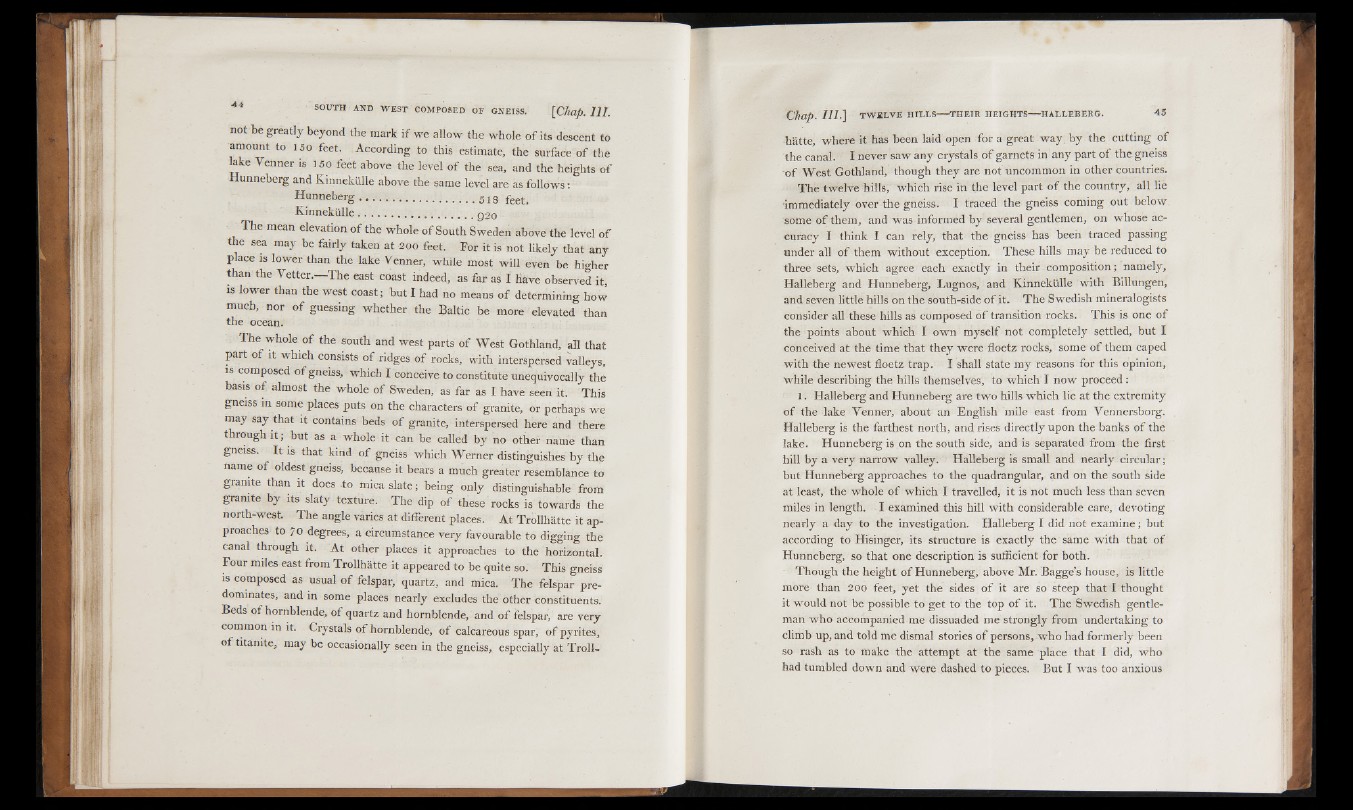
not be greatly beyond the mark if we allow the whole o f its descent to
amount to 150 feet. According to this estimate, the surface o f the
lake Venner is 15 o feet above the level o f the sea, and the heights o f
Hunneberg and Kinnekiille above the same level are as follows:
Hunneberg....................................... feet>
Kinnekiille .....................................020
The mean elevation o f the whole o f South Sweden above the level o f
the sea may be fairly taken at 200 feet. For it is not likely that any
place is lower than the lake Venner, while most will even be higher
than the Vetter.— The east coast indeed, as far as I Have observed it,
is lower than the west coast; but I had no means of determining how
much, nor o f guessing whether the Baltic be more elevated than
the ocean.
The whole o f the south and west parts of West Gothland, an that
part of it which consists o f ridges o f rocks, with interspersed valleys,
is composed of gneiss, which I conceive to constitute unequivocally the
basis o f almost the whole of Sweden, as far as I have seen it. This
gneiss in some places puts on the characters of granite, or perhaps we
may say that it contains beds o f granite, interspersed here and there
through i t ; but as a whole it can be called by no other name than
gneiss. It is that kind o f gneiss which Werner distinguishes by the
name o f oldest gneiss, because it bears a much greater resemblance to
granite than it does .to mica slate; being only distinguishable from
granite by its slaty texture. The dip of these rocks is towards the
north-west. The angle varies at different places. At Trollhatte it approaches
to 70 degrees, a circumstance very favourable to digging the
canal through it. At other places it approaches to the horizontal.
Four miles east from Trollhatte it appeared to be quite so. This gneiss
is composed as usual o f felspar, quartz, and mica. The felspar predominates,
and in some places nearly excludes the other constituents.
Beds of hornblende, o f quartz and hornblende, and o f felspar, are very
common in it. Crystals of hornblende, of calcareous spar, o f pyrites,
of titanite, may be occasionally seen in the gneiss, especially at Trollhatte,
where it has been laid open for a great way. by the cutting of
the canal. I never saw any crystals o f garnets in any part of the gneiss
o f West Gothland, though they are not uncommon in other countries.
The twelve hills, which rise in the level part of the country, all lie
•immediately over the gneiss. I traced the gneiss coming out below
some o f them, and was informed by several gentlemen, on whose accuracy
I think I can rely, that the gneiss has been traced passing
under all of them without exception. These hills may be reduced to
three sets, which agree each exactly in their composition; namely,
Halleberg and Hunneberg, Lugnos, and Kinnekiille with Billungen,
and seven little hills on the south-side of it. The Swedish mineralogists
consider all these hills as composed o f transition rocks. This is one of
the points about which I own myself not completely settled, but I
conceived at the time that they were floetz rocks, some o f them caped
with the newest floetz trap. I shall state my reasons for this opinion,
while describing the hills themselves, to which I now proceed:
1 . Halleberg and Hunneberg are two hills which lie at the extremity
o f the lake Venner, about an English mile east from Vennersborg.
Halleberg is the farthest north, and rises directly upon the banks of the
lake. Hunneberg is on the south side, and is separated from the first
hill by a very narrow valley. Halleberg is small and nearly circular;
but Hunneberg approaches to the quadrangular, and on the south side
at least, the whole o f which I travelled, it is not much less than seven
miles in length. I examined this hill with considerable care, devoting
nearly a day to the investigation. Halleberg I did not examine; but
according to Hisinger, its structure is exactly the same with that of
Hunneberg, so that one description is sufficient for both.
Though the height o f Hunneberg, above Mr. Bagge’s house, is little
more than 200 feet, yet the sides of it are so steep that I thought
it would not be possible to get to the top of it. The Swedish gentleman
who accompanied me dissuaded me strongly from undertaking to
climb up, and told me dismal stories o f persons, who had formerly been
so rash as to make the attempt at the same place that I did, who
had tumbled down and were dashed to pieces. But I was too anxious